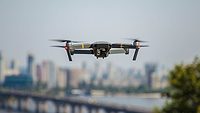Building trust through transparency

Image courtesy of Axis
The New Windsor Police Department (NWPD) in New York wanted to equip its officers with body cameras to increase transparency and help quickly resolve civilian complaints. In addition to enhancing public trust in the police, the department was looking for the ability to capture forensic quality video at a scene if investigations were needed.
Of utmost importance to the NWPD was a camera that was lightweight, rugged and reliable to deal with challenging circumstances. The department took recommendations from New Windsor’s IT Department and began a testing and bidding process for competing vendors.
Ultimately, the department chose the Axis body-worn camera and started with a purchase of 50 cameras for their patrol officers, detectives and administrators. The solution also included two system controllers and seven eight-bay docking stations to automatically offload video and recharge body cameras after each shift.
Additionally, the department installed a video management system to simplify camera updates and store, view and export video evidence.
The camera’s single-tap activation and pre-recording buffer ensure patrol officers capture incidents as they unfold. The forensic-quality video can also help the department provide supporting evidence in courtroom proceedings.
Detectives review videos from multiple on-scene cameras to gain different perspectives on incidents. Cameras give them the option to record their interviews in the field instead of bringing individuals to the police station.
A programmable pre-buffer feature on the cameras records 30 to 90 seconds of video in case an officer does not turn on their camera immediately.
To protect video integrity, the NWPD sets user permissions and views activity logs within the video management system, ensuring that only authorized personnel can view video evidence and make changes in the system. Patrol officers who share desktops in the bullpen use unique credentials logging into the video management software to view their own body camera video. Sergeants are authorized to view footage from all patrol officer cameras. Detectives also have access to any patrol officer video relevant to an investigation. Reviewing footage from multiple officers on the scene helps detectives compare different perspectives of an event.
The camera software simplifies updating the cameras with the latest software and firmware and simplifies storing, viewing and exporting video evidence. In addition, the software provides NWPD with customizable incident reports, a bookmarking function for easy video searches and video redaction to mask objects and innocent bystanders in the frame.
Administrators sometimes wear the body cameras as a convenient way to document interactions with the public.
In essence, the NWPD hopes that the body-worn cameras will help strengthen community relations and protect officers on duty.
“The Axis body worn cameras not only verify how our officers are performing in the field, they also help us quickly resolve any civilian complaints. That kind of transparency not only builds public trust and confidence in the work we do, but also improves officer safety,” says Police Chief Robert Doss, New Windsor Police Department.
Community businesses back body camera investment
When Police Chief Robert Doss proposed that the NWPD invest in body worn cameras, he felt the transparency afforded by the technology would provide a huge step forward in officer safety and police-community relations. But for a small town like New Windsor, New York, many of the solutions on the market were far too expensive to consider.
“Some of the quotes coming in were as high as $250,000 for a five-year contract,” says Patrick Mangan, Deputy IT Officer for the town of New Windsor. “Plus, they wanted us to store the video in the cloud. That was way beyond our budget.”
Then, Axis Communications introduced to the market a new wearable camera solution. Since the town was already securing many town-owned properties with Axis cameras, Mangan recommended that the department check out the new offering.
The department found great results with the testing phase and liked the fact that they could store video on existing servers instead of paying for cloud storage.
Community buy-in was also important to Chief Doss. His outreach efforts helped secure community support for the project right from the start. In fact, most of the technology’s $37,000 price tag was funded by generous donations from local businesses, which took the burden off of taxpayers.
Future outlook
One safety feature of the body-worn solution that stands out for the NWPD is the cameras’ ability to turn on automatically if an officer falls or is pushed to the ground. Chief Doss is also exploring the possibility of adding a holster sensor, which can automatically initiate a recording from the body-worn camera when an officer removes a holstered device.
“The Axis body cameras have proven a smart investment for our department and our community,” Chief Doss says. “They give us the transparency we need to foster public trust and quickly resolve civilian complaints. Furthermore, when people know our officers are recording the interaction, it often helps to de-escalate the situation. And that makes our streets a safer place for everyone.”
This article originally ran in Security, a twice-monthly security-focused eNewsletter for security end users, brought to you by Security Magazine. Subscribe here.
Looking for a reprint of this article?
From high-res PDFs to custom plaques, order your copy today!





